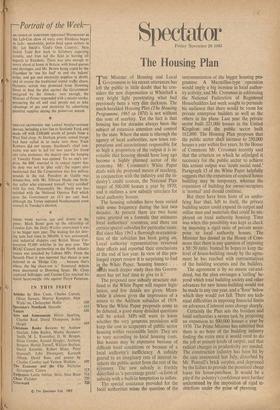The Housing Plan
THE Minister of Housing and Local Government in his recent utterances has left the public in little doubt that he con- siders the new dispensation at Whitehall a very bright light penetrating what had previously been a very dim darkness. The much-heralded Housing Plan (The Housing Programme, 1965 to 1970) is not without this note of acerbity. Yet the fact is that housing has for decades always been the subject of extensive attention and control by the state. Where the state is (through the agency of local authorities, new town cor- porations and associations) responsible for so high a proportion of the output it is in- evitable that housing should have long ago become a highly planned sector of the economy. Mr. Crossman's White Paper deals with the proposed means of reaching, in conjunction with the industry and the in- dustry's credit sources, the National Plan target of 500,000 houses a year by 1970; and it outlines a new subsidy structure for local authority houses.
The housing subsidies have been varied with some frequency during the last two decades. At preserit there are two basic rates, granted on a formula that estimates local authorities' resources, and there are certain special subsidies for particular cases. But since May 1963 a thorough re-examina- tion of the subsidies has been going on. Local authority representatives' reviewed their effects and reported their conclusions at the end of last year. In view of this pro- longed expert review it is surprising to find itLthe White Paper, `housing finance . . . Mds much deeper study than this Govern- ment has yet had time to give to it.'
The proposed new subsidy structure out- lined in the White Paper will require legis- lation, and few details are given. Mean- while it almost gives the impression of a return to the Addison subsidies of 1919. When the White Paper proposals come to be debated, a good many detailed questions will be asked. MPs will want to know whether the very generous provisions will keep the cost to taxpayers of public sector housing within reasonable limits. They are to vary according to local housing costs. But houses may be expensive because of difficult local conditions or because of a local authority's inefficiency. A subsidy geared to an imaginary rate of interest, in- sulates the public sector from the rest of the economy. The new subsidy is frankly &Scribed as `a percentage grant'—a form of subsidy with,a built-in temptation to inflate. The special assistance provided for the local authorities raises the question of the instrumentation of the bigger housing pro- gramme. A Macmillan-type operation would imply a big increase in local author- ity activity; and Mr. Crossman in addressing the National Federation of Registered Housebuilders last week sought to persuade his audience that there would be room for private enterprise builders as well as the others in his plans. Last year the private sector built 221,000 houses in the United Kingdom and the public sector built 162,000. The Housing Plan proposes that the public sector shall increase to 250,000 houses a year within five years. In the House of Commons Mr. Crossman recently said that the criterion on which he adjudged it necessary for the public sector to achieve this annual output was `acute social need.' Paragraph 15 of the White Paper helpfully suggests that the expansion of council house building may be temporary, whereas the expansion of building for owner-occupiers is `normal' and should continue.
But there have been hints of an under- lying fear that, left to itself, the private building sector could expand its output and utilise men and materials that could be em- ployed on local authority housing. Time was when this possibility was kept in check by imposing a rigid ratio of private enter- prise to' local authority houses. The Minister has denied in the House of Com- mons that there is any question of imposing a 50: 50 ratio. Instead he hopes to keep the level of house-building steady by the agree- ment he has reached with representatives of the building societies and the builders.
The agreement is by no means cut-and- dried, but the plan envisages a `ceiling' be- yond which total building society and other advances for new house-building would not be made in any one year, and a `floor' below which they would not fall. There are tech- nical difficulties in imposing financial limits on advances if interest rates change sharply.
Certainly the Plan sets the builders and local authorities a severe task by proposing an expansion to 500,000 houses a year by 1970. The Prime Minister has admitted that there is no hope of the building industry finding the extra men it would need to do the job at present levels of output, and that radical changes in productivity are needed. The construction industry has been hit by the cuts announced last July, disturbed by Mr. Pannell's brick surplus, and depressed by the failure to provide the promised cheap loans for house-purchase. It would be a pity if the industry's confidence were further undermined by the imposition of rigid re- strictions under the guise of planning.


















































 Previous page
Previous page